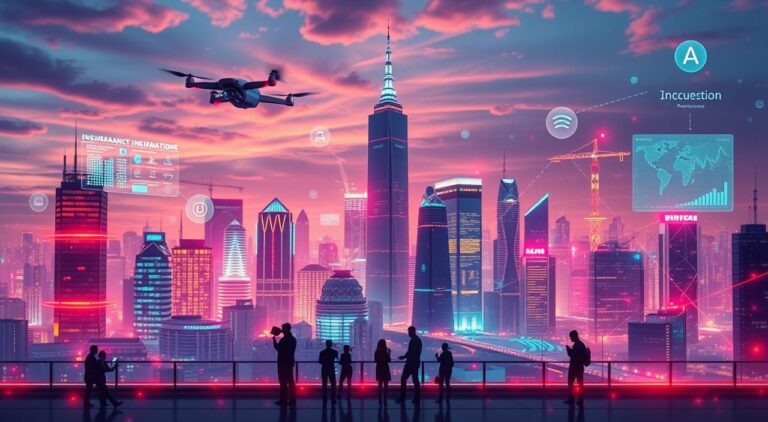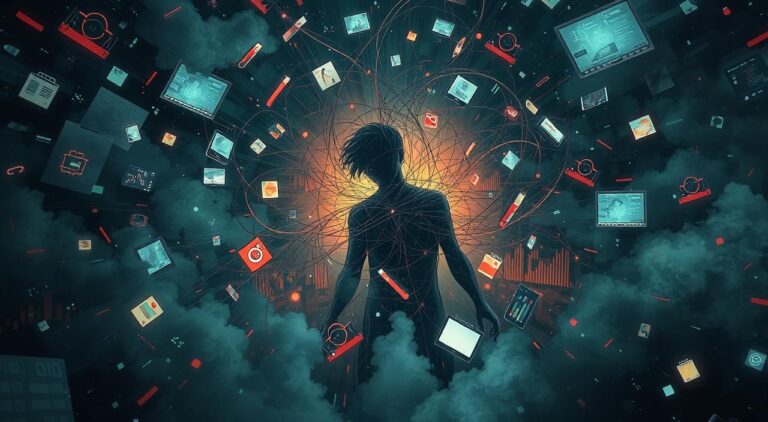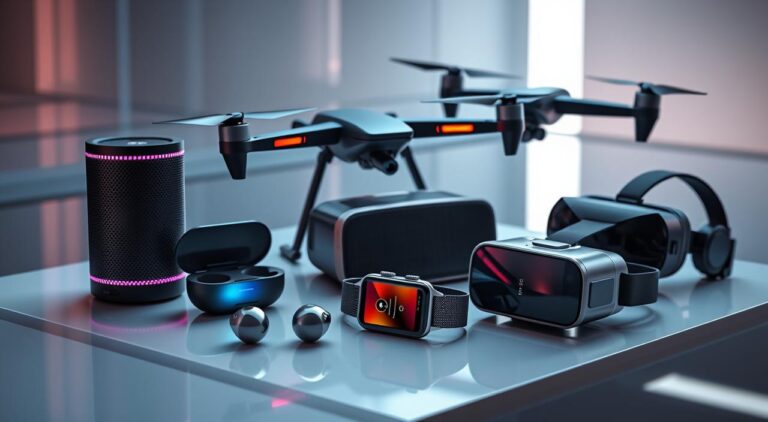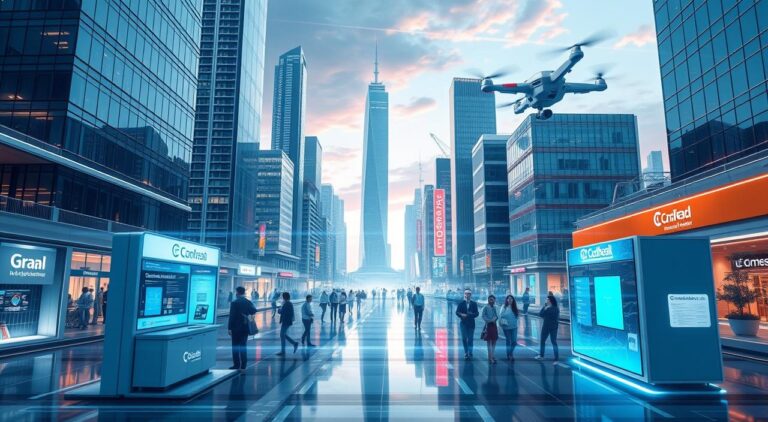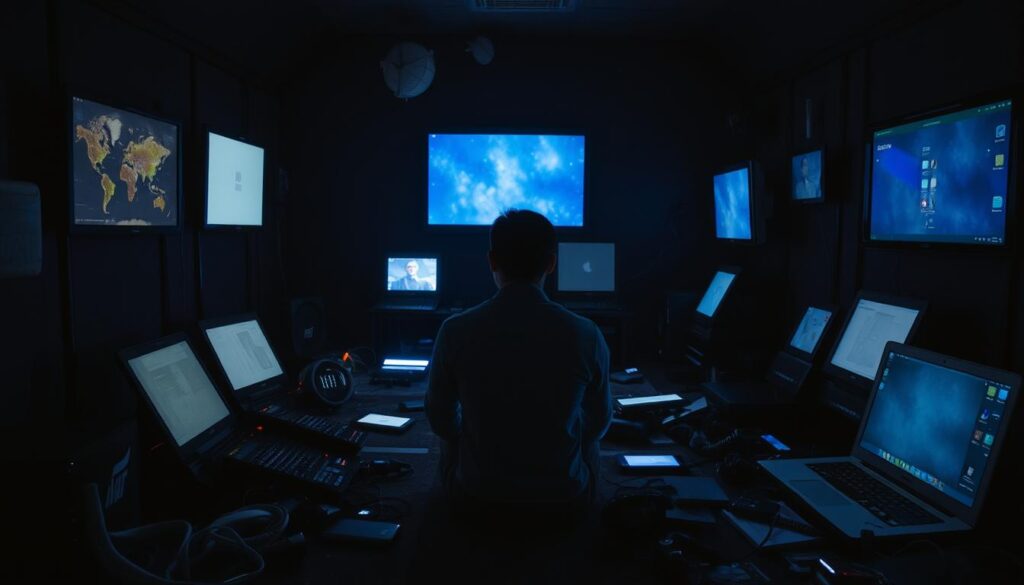
In our fast-changing digital world, technology is a big part of our lives. It has many benefits, but too much use can harm us. We need to ask: Are we in control of the technology, or is it controlling us?
Key Takeaways
- Too much tech use can make us feel alone and hurt our relationships.
- Long hours on screens can hurt our mental health, causing stress, sadness, and addiction.
- Being on devices all day can also harm our bodies, like our eyes and posture, and mess up our sleep.
- The digital world brings new dangers to our privacy and security, risking our personal info.
- Dependence on tech can slow down how our brains grow, especially in young people.
Understanding the Digital Age’s Dark Side
As we dive into the digital revolution, it’s key to see its dark side. Our growing tech use has negative effects we must address.
The Evolution of Technology Dependence
Technology is now a big part of our lives. In the UK, 94% of adults have a mobile phone, with most being smartphones. A Deloitte survey found that many use their phones more than making calls, using them for various tasks.
UK residents check their phones about 85 times a day. They use them for around five hours each day.
Current Technology Usage Statistics
Younger people use technology a lot, which is worrying. Studies link heavy phone and internet use to poor brain skills. Using phones at night can also mess with sleep and alertness.
The Need for Digital Awareness
With more digital dependence, we need to be aware of its dangers. Social media can cause anxiety and depression. Too much multitasking on media can also harm our brains.
“The digital age has brought unprecedented convenience and connectivity, but it has also unveiled a dark side that demands our attention and action.”
Understanding the technology usage trends today is vital. It’s important for our health and the future of our kids.
| Statistic | Insight |
|---|---|
| 1 in 3 teenagers are victims of cyberbullying | Cyberbullying is a big problem that can hurt young people’s mental health. |
| 39% of teens admit to have sent sext messages | Sexting among teens shows we need to teach them about digital safety. |
| Almost half of the teenagers have received digital messages containing nudity | Teens sharing explicit content is a worrying trend that affects their well-being. |
Mental Health Concerns in the Digital Era
Our world is getting more digital by the day. This change affects our mental health a lot. Studies show we need to tackle the mental health issues caused by our tech use.
A 2017 study looked at young adults aged 19–32. It found that those who used social media a lot felt more lonely. A 2016 review linked social media to digital depression and social media anxiety. But, positive interactions on social media could help lower these issues.
The constant need to check notifications and compare ourselves online can cause “Chronic Smartphone Stress.” This stress can make us anxious and restless. It can harm our well-being and quality of life.
“Smartphones have become so ingrained in our daily lives that we often fail to recognize the toll they can take on our mental health. The constant need to stay connected and the pressure to curate a perfect online persona can be overwhelming, leading to increased digital depression and social media anxiety.”
We need to find a balance in our digital lives to protect our online mental health. Being aware of our tech use and getting help when needed can help. This way, we can enjoy the good things technology brings into our lives.
What are the five negative impacts of using technology in society?
In today’s digital world, it’s important to see the downsides of technology. Key concerns include social media depression, digital stress, and addiction to technology.
Social Media’s Role in Modern Depression
Studies show that social media can make us feel less happy and more depressed. A University of Michigan study found that Facebook use made people less happy. Seeing perfect lives on social media can make us feel bad about ourselves.
Digital Anxiety and Stress
Digital devices and always being connected cause digital anxiety and stress. A Swedish study linked heavy phone use in young adults to depression. Feeling like we must always be available can harm our mental health.
Technology Addiction Patterns
Technology addiction, especially with the internet, is a big problem. The CDC says ADHD diagnoses have risen 43% since 2003. This might be because of too much screen time and constant digital stimulation.
We need to find a balance with technology to protect our mental and physical health. By understanding these issues, we can have a healthier relationship with technology.
“The constant exposure to carefully curated social media posts can foster feelings of inadequacy and envy, exacerbating mental health challenges.”
Physical Health Implications of Excessive Screen Time
In today’s world, we spend a lot of time on screens. This has led to many health problems. Issues like digital eyestrain and poor posture are common.
Digital eyestrain is a big problem. It causes blurred vision, dry eyes, and headaches. The American Optometric Association says it can really hurt our health.
Also, sitting for long periods can hurt our muscles. Hunching over devices can cause neck, shoulder, and back pain. A study showed that texting can lead to pain in young adults.
| Negative Health Impact | Potential Consequences |
|---|---|
| Digital Eyestrain | Blurred vision, dry eyes, headaches |
| Tech-Related Posture Issues | Neck, shoulder, and back pain |
| Obesity | Sedentary lifestyles, reduced physical activity |
Too much screen time also makes us more likely to be obese. Especially for young people in America. Now, 18.5% of American youth are obese.
We need to be careful about how much time we spend on screens. Taking breaks, sitting right, and using technology wisely can help us stay healthy.
The Impact on Sleep Quality and Patterns
In today’s world, we use technology a lot, even at night. The blue light from our devices can mess with our sleep cycle. A 2014 study showed it can make falling asleep harder or make us feel less alert the next day.
Using tech at night, like scrolling on social media or watching shows, can lead to insomnia and poor sleep. Many teens sleep with their phones nearby, with a third keeping them on their bed. This constant blue light and engaging content can mess up our sleep patterns, causing sleep deprivation and health problems.
Blue Light Effects on Circadian Rhythm
The blue light from devices tricks our brains into thinking it’s still daytime. This stops our body from making melatonin, the sleep hormone. This messes with our sleep-wake cycle, making it hard to fall asleep and affecting sleep quality, leading to blue light sleep disruption.
Nighttime Technology Use
Smartphones, tablets, and other devices are everywhere, even at bedtime. Using them before sleep can make it hard to relax and get ready for bed. This can lead to tech-induced insomnia.
Sleep Deprivation Consequences
Not getting enough sleep can harm our minds and bodies. It can cause problems like poor focus, mood swings, and even serious health issues. In kids and teens, it can lead to behavioral and emotional problems, as well as trouble focusing and less physical activity.
To stay healthy, we need to focus on good sleep habits and limit tech use before bed. By choosing to disconnect and creating a sleep-friendly space, we can improve our sleep quality and handle the digital world better.
Social Isolation and Relationship Deterioration
In today’s world, technology has both good and bad sides for social interactions. It’s meant to bring people together, but too much of it can lead to tech-induced isolation. This can harm our personal connections.
A 2017 study showed that heavy social media users feel more isolated. Virtual chats can make us feel disconnected. Even married couples text each other while together, leading to misunderstandings and stress.
“About half of the respondents in the study believed that the positives of digital life would continue to outweigh the negatives in the future. Roughly one-third of respondents predicted that harms to well-being would surpass the positives overall within the next decade.”
Studies say that internet use and social media loneliness affect people differently. Younger people feel lonelier than older ones. But, older folks who use the internet can feel less lonely if they also have real-life friends.
We need to use technology wisely to keep our human connections strong. By balancing our online and offline lives, we can build better relationships in today’s world.
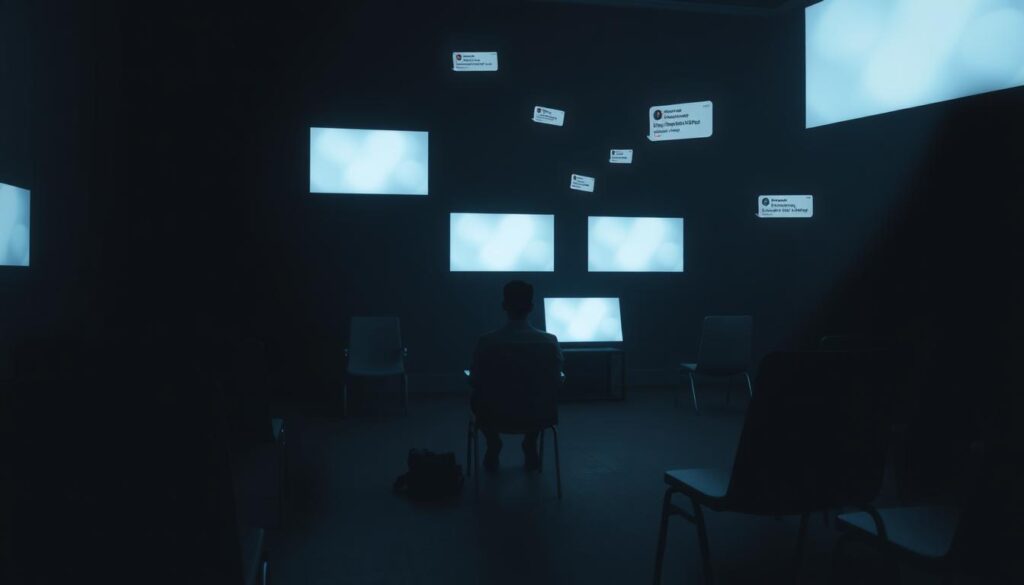
Cybersecurity Threats and Privacy Concerns
In today’s digital world, we face many cybersecurity risks and privacy concerns. Hackers and cybercriminals are always trying to get our personal data. This can lead to identity theft and data breaches.
Malware, ransomware, and phishing scams are just a few ways our digital identities can be at risk. These threats are getting more complex every day.
Personal Data Vulnerability
We store a lot of personal info online and share it through digital platforms. This makes us vulnerable to cyber threats. Malware and ransomware can get into our devices and steal our private data.
In May 2017, a big ransomware attack hit over 100,000 organizations worldwide. It caused a lot of financial damage. It’s important to use strong passwords and securely delete data to protect ourselves.
Digital Identity Protection
Our digital identities are a big part of our lives, and protecting them is more important than ever. Cyberbullying is a big problem, affecting 32% of teens. Many teens find it hard to tell their parents about it.
Only 11% of teens talk to their parents about cyberbullying. This shows we need better protection for our digital identities and to talk more about these issues.
Online Safety Measures
- Implement strong password management practices
- Stay vigilant against phishing attempts and social engineering attacks
- Keep software and devices up-to-date with the latest security patches
- Use trusted antivirus and anti-malware solutions
- Be cautious when sharing personal information online
- Regularly back up important data to secure, off-site locations
By learning and taking steps to protect our digital identities, we can feel safer online. We can keep our privacy safe from new threats.
Technology’s Effect on Cognitive Development
In today’s world, kids and teens face a big challenge – technology’s impact on their brains. Studies show the risks and challenges this brings to the younger generation.
ADHD or ADD cases have jumped by 43% from 2003 to 2016. A study in the Journal of the American Medical Association (JAMA) found teens who use digital media a lot are more likely to get ADHD.
Also, technology might be hurting kids’ creativity. They play less and watch more digital shows. This makes it hard for them to think deeply and focus on complex tasks.
| Statistic | Impact |
|---|---|
| 43% increase in ADHD or ADD diagnoses between 2003 and 2016 | Increased risk of ADHD in teenagers who frequently use digital media |
| Decreased attention span from 12 seconds to 8 seconds due to increased technology use | Difficulties in focusing on complex tasks and engaging in deep thinking |
| Teenagers spend up to 9 hours per day on screens | Potential delays or irregularities in cognitive, physical, and social development |
We must understand the deep digital cognitive impact of technology on kids. Knowing how tech and brain development connect helps us tackle the digital age’s challenges. We can make sure our kids use technology in a healthy way.
“The more time children spend in front of a screen, the more likely they are to experience delays in language development, social skills, and attention span.”
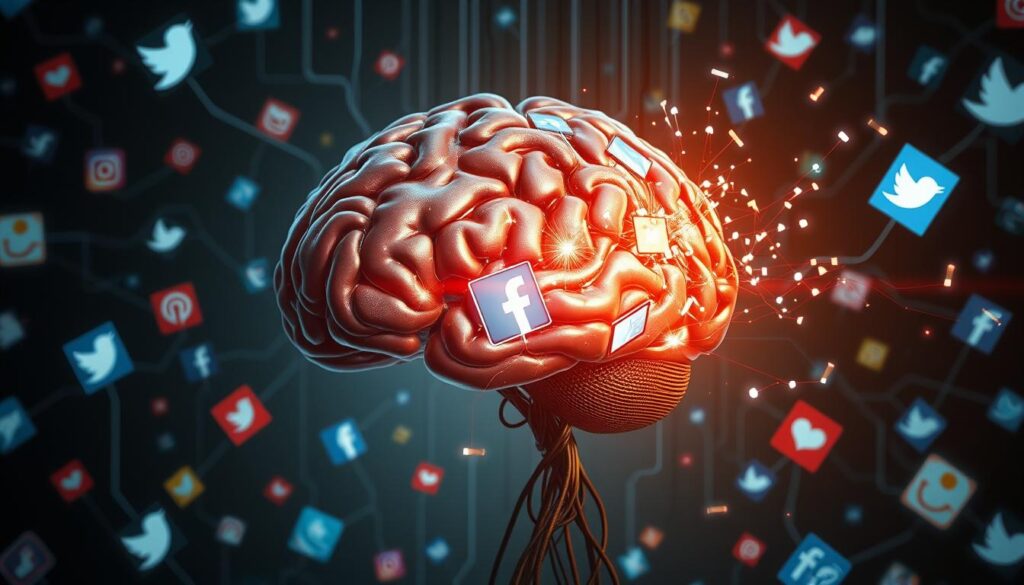
Environmental Impact of Digital Consumption
Technology has grown a lot, and so has its environmental impact. Our use of electronic devices and digital services is increasing. This means more energy is needed to power and make these technologies. The digital world is now a big user of energy, causing pollution and harming the environment.
The problem of e-waste is getting worse. Old or broken gadgets are often thrown away, creating a huge amount of electronic waste. Making and getting rid of these devices also worries us about running out of resources and dealing with toxic waste.
The tech energy consumption for data centers, cloud computing, and other digital stuff has gone up a lot. One data center can use as much energy as a small city. With the digital world growing fast, the harm to the environment is getting worse.
| Statistic | Impact |
|---|---|
| Digital technology accounts for 4% of global greenhouse gas emissions, potentially doubling to 8% by 2025. | The digital industry’s significant contribution to climate change highlights the need for more sustainable practices. |
| Producing a single smartphone requires up to 70 different materials and 50 metals, with only 20 being recyclable. | The resource-intensive nature of digital technology production exacerbates environmental degradation and resource depletion. |
| Data centers consume the equivalent energy of a city with 50,000 inhabitants. | The energy-intensive nature of digital infrastructure underscores the need for more efficient and renewable-powered data centers. |
We need to work together to make the digital world more sustainable. By reducing e-waste, using less energy, and using renewable energy, we can lessen the harm. This will help reduce our tech energy consumption and digital carbon footprint.
“The digital galaxy comprises 75 million servers, 34 billion user terminals, and 1.5 billion communication networks, with predictions that the digital universe will grow 5 times between 2010 and 2025.”
Workplace Challenges in the Digital Age
The modern workplace faces unique challenges in the digital age. One major issue is job loss due to automation. Over 25 million jobs will be lost in three years, mainly in roles like cashiers and ticket agents.
Artificial intelligence (AI) could replace 300 million jobs worldwide. This change is due to rapid advancements in technology.
Job Displacement Due to Automation
Technological innovations have changed the job landscape. These changes have made work more efficient but also disrupted traditional jobs. Today, 60% of jobs didn’t exist 80 years ago.
Since 1940, employment has grown by 85% thanks to technology. Yet, this growth has made jobs less secure. A study found that many employees in the U.S. and Asia worry about robots taking their jobs, even where robots aren’t used.
Digital Stress in the Workplace
Digital tools have increased stress at work. Employees feel they must be available all the time. This constant availability can harm physical health.
Many tech jobs are sedentary, and digital distractions lower productivity. This leads to more stress at work.
Work-Life Balance Issues
The digital age has made it hard to balance work and personal life. Millennials check their phones up to 80 times a day. This constant connection to work can cause burnout.
To solve these problems, we need strategies for better work-life balance. Providing resources for improving communication skills can also help.

